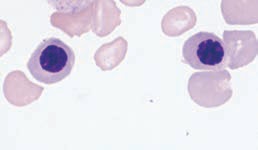Principle
D-dimer is a fibrin fragment that results when plasmin acts on cross-linked fibrin in the presence of factor XIII. D-dimers are produced from an insoluble fibrin clot. Available since the 1990s, this semiquantitative assay provides evidence of normal or abnormal levels of D-dimer. Latex particles are coated with mouse anti–D-dimer monoclonal antibodies. When mixed with plasma containing D-dimers, agglutination occurs. The test plays an important role in detecting and monitoring patients suspected to have thrombotic disorders. Its clinical uses include:
- Detecting deep vein thrombosis (DVT)
- Pulmonary embolism (PE)
- Disseminated intravascular coagulation (DIC)
- Postoperative complications
- Septicemia.
Quantitative D-dimer procedures are available, using latex-enhanced turbidimetric methods. The qualitative test is widely used in most coagulation laboratories, however, as a screening test for D-dimers.
Reagents and Equipment
1. D-dimer kit containing reagents (stored at 2 to 8°C), good until expiration date on the kit
a. Test reagent solution containing red blood cell anti–XL-FDP antibody conjugate
b. Negative control solution containing 0.9% saline solution
c. Positive control solution containing purified D-dimer fragment
2. Plastic agglutination trays
3. White plastic stirrers
4. Timer
5. 10-μL pipette with disposable tips
Specimen Collection and Storage
1. Collect venous whole blood into a vacuum tube with 3.2% sodium citrate. Dilution of blood to anticoagulant must be 9:1 .
a. 4.5 mL of blood with 0.5 mL of anticoagulant, or
b. 2.7 mL of blood with 0.3 mL of anticoagulant
2. Collection of venous blood into heparin is acceptable.
3. Store specimens at 18 to 24°C. Specimens should be tested within 4 hours of specimen collection. If testing will take place after 4 hours, specimens must be refrigerated at 2 to 8°C; refrigerated specimens are good up to 24 hours.
Quality Control
1. Quality control is performed under several conditions:
a. Daily
b. When opening a new kit
c. When receiving a new shipment
d. When a new lot number is put into use
2. A whole blood sample that has a negative D-dimer result is used for quality control.
3. Quality control method
a. Follow directions in the procedure to do the quality control, steps 1 through 5.
b. Add 1 drop of positive control to the test well, and proceed with steps 6 through 8b.
Procedure
1. Allow reagents to come to room temperature for at least 20 minutes before use.
2. Specimen should be thoroughly mixed; do not allow cells to settle out.
3. For each sample, pipette 10 μL of whole blood into each reaction well; place wells on a plastic agglutination tray; the first is labeled “negative control well” and the second is labeled “test well.”
4. Add 1 drop of the negative control to the negative control well.
5. Add 1 drop of the test reagent to the test well.
6. With a plastic stirrer, mix the contents of each well thoroughly for 3 to 5 seconds, using a different stirrer for each well and spreading the reagent across the entire well surface.
7. To promote agglutination, mix by gentle rocking of the plastic agglutination tray for 2 minutes.
8. At the end of the 2 minutes, observe for the presence of agglutination.
a. Positive results: Agglutination is present in the test well compared with no agglutination
in the negative control well.
b. If the negative control well agglutinates, the test is invalid.
c. If the test result is negative, add 1 drop of positive control to the test well and rock the plastic tray. Agglutination should occur within 15 seconds. If agglutination does not occur with the addition of the positive control, the test is invalid.
Interpretation
1. Positive: Agglutination seen in the test well and no agglutination seen in the negative control well.
2. Negative: No agglutination seen in the test well and the negative control well. This would be confirmed by adding the positive control to the test well and observing agglutination.
3. Invalid
a. Agglutination occurs in the negative control well.
b. No agglutination occurs with the positive control.
Results
- Negative: No agglutination seen in negative agglutination well (less than 0.5 mg/L)
- Positive: Agglutination seen in undiluted sample (0.5 to 4.0 mg/L)
- Positive samples can be diluted 1:8 or 1:64 to provide more specific semiquantitative data on the amount of D-dimer present.
Limitations
The presence of cold agglutinins in patient samples can cause agglutination in patient blood. This may cause agglutination of the negative control, invalidating the test results.
A quantitative D-dimer test is available, and it is usually performed using a turbidimetric procedure on automated coagulation equipment. The advantage of this method is that it gives an absolute quantity of D-dimer in milligrams per liter, which is an effective tool for determining whether a thrombotic episode has occurred or predicting whether one will occur.




































